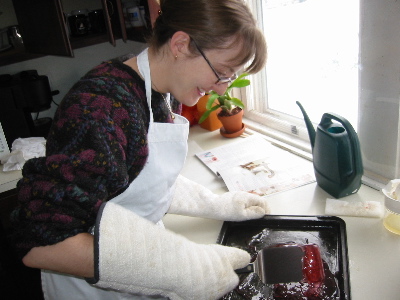Experiments in sucrose polymerization
Apparently under the influence of Martha’s evil spell, Elizabeth decided to make candy canes this past weekend. Basically you put sugar, corn syrup and about 22 water molecules into a pot and heat it up to a lightly scary 305° F (150 C) to polymerize the sugar, then work it for shape and texture on the way back to room temperature.

In the first batch we followed Martha’s recipes scrupulously, at least as scrupulously an ordinarily talented person can. (Remember back in elementary school when you did clay in art class? That “mug” you made that looked more like ejecta from Mt. St. Helens? The fact that it took three tries for your mug to meet the minimum liquid-restraining requirements of a mug while across the table the art teacher’s favorite student Suzy fashioned a thin, delicately featured decorative mask out of same fired clay? Suzy works for Martha now.)
Anyway. Martha has you add the flavorings and pour the syrup onto a greased cookie sheet immediately after reaching hard crack stage. This did not work at all well. The syrup is very sticky when hot but less so as it cools. With a cookie sheet, the top of the syrup cooled first, which meant that we both couldn’t get the syrup off the cookie sheet for a long time and when we could, it was too cool to work with. On top of this our awful “Baker’s Secret” cookie sheet dumped little bits of black so-called non-stick coating into the mix. Grumble grumble.
Since sugar is so darn cheap we decided to be profligate and try again. This time we reached for that old stand-by the Joy of Cooking. I either made candy with my mom when I was young or re-read this section of the cookbook a bunch of times at age 7 or both so I knew what it would recommend. We dug out our marble cutting board, greased it and threw it in the fridge (ok, that’s my addition) while making the next batch of candy. This time, following the Joy we let the candy syrup cool to just under 200° F (93 C), then stirred in the peppermint flavoring, finally leaving it quiescent under very low heat at about 190° F. (The Joy also suggests using peppermint oil instead of peppermint extract, which is mostly alcohol. This is a good idea since the alcohol blows away shockingly fast.) I poured batches of syrup onto the cooled marble slab which Elizabeth proceeded to fold and stretch. This was cool! I don’t have any pictures, unfortunately. Elizabeth turned out to be much more heat tolerant that I was so she did all of the repeated folding and pulling. I helped chop the candy canes into sticks with scissors.
Since the syrup is 100 degrees cooler when poured using the Joy approach, it is a lot more viscous and much less trouble to keep under control. It’s not like you can actually work the stuff with your hands until it is down to 150° F or so anyway, so there’s really no point to pouring it at a high temperature. Having the syrup mass cool from the bottom rather than the top and having a smooth, ungougeable surface is really essential to this process and marble works great. It’s surprising that Martha’s recipe doesn’t call for a marble slab; I should think that any self-respecting Martha acolyte would have one already!
The other point re-confirmed while heating sugar without stirring it: All-Clad pots rock!
[/food]
A decent Ma-Po Tofu recipe
Elizabeth and I have been to this restaurant in NYC a couple of times and it is quite good. Their Ma-Po tofu recipe showed up in the the Times once and it has become a staple around our house.
Here’s a really crummy scan of the Times article.The key ingredient are the Sichuan peppercorns, which Elizabeth grinds up in an old coffeegrinder. Sichuan peppercorns are hard to find; we get them from Narrin’s Asian Spice and Sauce at the West Side Market in Cleveland.
[/food]
